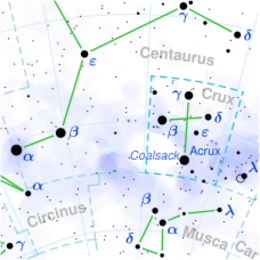Astronomy:DS Crucis
| Observation data Equinox J2000.0]] (ICRS) | |
|---|---|
| Constellation | Crux |
| Right ascension | 12h 51m 17.97637s[1] |
| Declination | −60° 19′ 47.2386″[1] |
| Apparent magnitude (V) | 5.741[2] |
| Characteristics | |
| Spectral type | A1 Ia[2] |
| U−B color index | −0.088[2] |
| B−V color index | +0.384[2] |
| Variable type | α Cyg?[3] |
| Astrometry | |
| Radial velocity (Rv) | −21.90[4] km/s |
| Proper motion (μ) | RA: −4.63±0.02[5] mas/yr Dec.: −0.94±0.03[5] mas/yr |
| Parallax (π) | 0.4534 ± 0.0296[5] mas |
| Distance | 7,200 ± 500 ly (2,200 ± 100 pc) |
| Absolute magnitude (MV) | −7.29[6] |
| Details | |
| Mass | 29[6] M☉ |
| Radius | 112[6] R☉ |
| Luminosity | 79,400[6] L☉ |
| Surface gravity (log g) | 1.45[2] cgs |
| Temperature | 9,150[2] K |
| Metallicity [Fe/H] | −0.11[6] dex |
| Rotational velocity (v sin i) | 17[2] km/s |
| Age | 7[6] Myr |
| Other designations | |
| Database references | |
| SIMBAD | data |
DS Crucis (HR 4876, HD 111613) is a variable star near the open cluster NGC 4755, which is also known as the Kappa Crucis Cluster or Jewel Box Cluster. It is in the constellation Crux.
Location
DS Crucis is one of the brightest stars in the region of the NGC 4775 open cluster, better known as the Jewel Box Cluster, but its membership of the cluster is in doubt.[7][8] The cluster is part of the larger Centaurus OB1 association and lies about 8,500 light years away.
DS Crucis and NGC 4755 lie just to the south-east of β Crucis, the lefthand star of the famous Southern Cross.
Variability
DS Crucis is a variable star with an amplitude of about 0.05 magnitudes. It was found to be variable from the photometry performed by the Hipparcos satellite. The variability type is unclear but it is assumed to be an α Cygni variable.[3]
Properties
DS Crucis is an A1 bright supergiant (luminosity class Ia), although it has also been classified as A2 Iabe. It is nearly 80,000 times the luminosity of the sun, partly due to its higher temperature of 9,000 K, and partly to being over a hundred times larger than the sun. The κ Crucis cluster has a calculated age of 11.2 million years, and DS Crucis an age of seven million years.[10]
References
- ↑ 1.0 1.1 van Leeuwen, F. (November 2007), "Validation of the new Hipparcos reduction", Astronomy and Astrophysics 474 (2): 653–664, doi:10.1051/0004-6361:20078357, Bibcode: 2007A&A...474..653V.
- ↑ 2.0 2.1 2.2 2.3 2.4 2.5 2.6 Firnstein, M.; Przybilla, N. (2012). "Quantitative spectroscopy of Galactic BA-type supergiants. I. Atmospheric parameters". Astronomy & Astrophysics 543: A80. doi:10.1051/0004-6361/201219034. Bibcode: 2012A&A...543A..80F.
- ↑ 3.0 3.1 Samus, N. N. et al. (2009). "VizieR Online Data Catalog: General Catalogue of Variable Stars (Samus+ 2007-2013)". VizieR On-line Data Catalog: B/GCVS. Originally Published in: 2009yCat....102025S 1. Bibcode: 2009yCat....102025S.
- ↑ Gontcharov, G. A. (November 2006), "Pulkovo Compilation of Radial Velocities for 35 495 Hipparcos stars in a common system", Astronomy Letters 32 (11): 759–771, doi:10.1134/S1063773706110065, Bibcode: 2006AstL...32..759G.
- ↑ 5.0 5.1 Brown, A. G. A. (2021). "Gaia Early Data Release 3: Summary of the contents and survey properties". Astronomy & Astrophysics 649: A1. doi:10.1051/0004-6361/202039657. Bibcode: 2021A&A...649A...1G. Gaia EDR3 record for this source at VizieR.
- ↑ 6.0 6.1 6.2 6.3 6.4 6.5 Przybilla, N.; Butler, K.; Becker, S. R.; Kudritzki, R. P. (2006). "Quantitative spectroscopy of BA-type supergiants". Astronomy and Astrophysics 445 (3): 1099–1126. doi:10.1051/0004-6361:20053832. Bibcode: 2006A&A...445.1099P.
- ↑ Dachs, J.; Kaiser, D. (November 1984), "UBV photometry of the southern galactic cluster NGC 4755 = Kappa Crucis", Astronomy and Astrophysics Supplement Series 58: 411–429, Bibcode: 1984A&AS...58..411D.
- ↑ Kharchenko, N. V.; Piskunov, A. E.; Röser, S.; Schilbach, E.; Scholz, R.-D. (2004). "Astrophysical supplements to the ASCC-2.5. II. Membership probabilities in 520 Galactic open cluster sky areas". Astronomische Nachrichten 325 (9): 740–748. doi:10.1002/asna.200410256. Bibcode: 2004AN....325..740K.
- ↑ "MAST: Barbara A. Mikulski Archive for Space Telescopes". Space Telescope Science Institute. https://mast.stsci.edu/portal/Mashup/Clients/Mast/Portal.html.
- ↑ Aidelman, Y.; Cidale, L. S.; Zorec, J.; Arias, M. L. (2012). "Open clusters. I. Fundamental parameters of B stars in NGC 3766 and NGC 4755". Astronomy & Astrophysics 544: A64. doi:10.1051/0004-6361/201219069. Bibcode: 2012A&A...544A..64A.
 |




